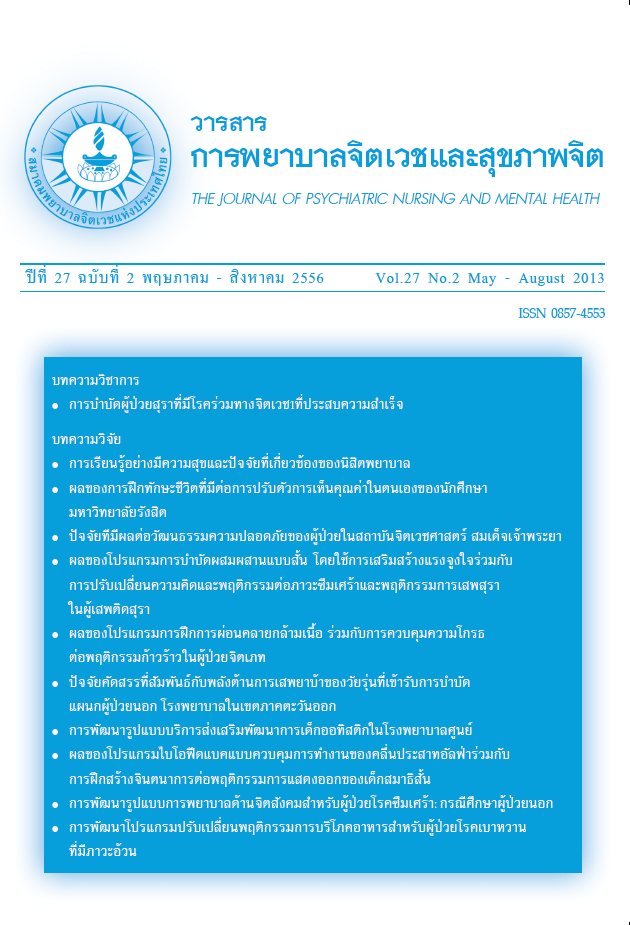การพัฒนารูปแบบบริการส่งเสริมพัฒนาการเด็กออทิสติกในโรงพยาบาลศูนย์
Main Article Content
บทคัดย่อ
การวิจัยครั้งนี้เป็นการวิจัยแบบผสมผสานมีวัตถุประสงค์เพื่อสร้างและพัฒนารูปแบบบริการส่งเสริมพัฒนาการเด็กออทิสติกสำหรับโรงพยาบาลศูนย์ กลุ่มตัวอย่างคือ ผู้รับบริการซึ่งเป็นผู้ปกครองของเด็กออทิสติกวัยเด็กเล็ก และผู้ให้บริการซึ่งเป็นหัวหน้าหน่วยบริการและผู้สอนส่งเสริมพัฒนาการ เครื่องมือที่ใช้ในการวิจัยคือแบบสอบถามและแบบสัมภาษณ์ การดำเนินการวิจัยแบ่งเป็น 3 ระยะ คือระยะที่ 1 ศึกษาสภาพปัจจุบัน ปัญหา และอุปสรรคในการบริการส่งเสริมพัฒนาการเด็กออทิสติกในโรงพยาบาลศูนย์โดยใช้แบบสอบถาม ระยะที่ 2 สร้างและพัฒนารูปแบบบริการส่งเสริมพัฒนาการเด็กออทิสติกโดยการสัมภาษณ์เชิงลึก และวิเคราะห์เอกสาร งานวิจัยต่างประเทศประกอบการพัฒนารูปแบบ และระยะที่ 3 ตรวจสอบคุณภาพของรูปแบบ รวมทั้งให้ข้อเสนอแนะในการนำไปใช้ ซึ่งในบทความนี้จะขอเสนอผลการวิจัยที่สำคัญที่พบในระยะที่ 1 และระยะที่ 2
ผลการวิจัย มีดังนี้
1. สภาพปัจจุบันในการบริการส่งเสริมพัฒนาการเด็กออทิสติกของโรงพยาบาลศูนย์ พบว่าด้านบุคลากร ให้บริการดีและเป็นมิตร มีกิจกรรมการสอนเด็กเหมาะสม แต่ยังขาดความรู้ในการสอนเด็กออทิสติก ด้านบริหารพบว่า นโยบายการให้บริการไม่ชัดเจน ผู้ปกครองต้องรอคิวนาน ยากลำบากและเสียค่าใช้จ่ายมากในการเดินทางเพื่อพาเด็กมารับบริการ และเวลาไม่เพียงพอต่อการพัฒนาเด็ก ด้านงบประมาณ ไม่มีงบประมาณในการจัดการสถานที่ซึ่งคับแคบ และด้านอุปกรณ์ ยังขาดอุปกรณ์ที่เหมาะสม2. รูปแบบบริการส่งเสริมพัฒนาการเด็กออทิสติกที่ได้จากผลการวิจัย มีองค์ประกอบที่สำคัญ 9 ประการ คือ 1) การส่งเสริมพัฒนาการตั้งแต่แรกเริ่มหรือเร็วที่สุด 2) การบริการช่วยเหลือแบบรายบุคคลและรายครอบครัว 3) การสอนที่เป็นระบบ 4) ใช้หลักสูตรและวิธีการสอนที่เฉพาะสำหรับเด็กออทิสติก 5) การช่วยเหลือหรือการสอนที่เข้มข้น 6) การมีส่วนร่วมของผู้ปกครอง 7) การทำงานระหว่างกลุ่มสหวิชาชีพ 8) มีเครือข่ายการบริการที่ดี และ 9) มีนโยบายที่ชัดเจนในการให้บริการส่งเสริมพัฒนาการเด็กออทิสติก
Abstract
The purpose of this mixed-method research was to develop the model of early intervention services for children with autism in regional hospitals. Samples were 161 parents of children with autism, and 21 providers. The instruments were questionnaires and interview protocols. Three stages of the study were: 1) investigating of the current status of early intervention services in regional hospital, 2) developing early intervention service model by reviewing and analyzing literature, and in-depth interviewing, and 3) evaluating the appropriateness and feasibility of the model proposed by experts. The report appeared in this paper had been focused on the results from stage 1 and 2.
Major results of this study were as follows:
1. The current status of early intervention services in regional hospital revealed by parents that the staffs provided services with kindness and good relationships, and provided appropriate activities to the child. However, parents reported that their child had to wait in cue in order to receive services, and difficult in traveling to receive services and high expenditure. Service providers indicated that times to provide interventions were limited, the policy were not clearly define, and personnel need more knowledge in teaching children with autism.
2. The early intervention service model for children with autism in the regional hospital were consisted of 9 elements; 1) providing interventions to children as early as possible, 2) individualized supports and services, 3) specialized curriculum, 4) systematic teaching, 5) intensive instructional programming, 6) parent involvement, 7) working collaborate among professionals, 8) good networking of services, and 9) clear policy in providing services to children with autism.
Article Details
บทความที่ได้รับการตีพิมพ์แล้ว เป็นลิขสิทธิ์ของสมาคมพยาบาลจิตเวชแห่งประเทศไทย


